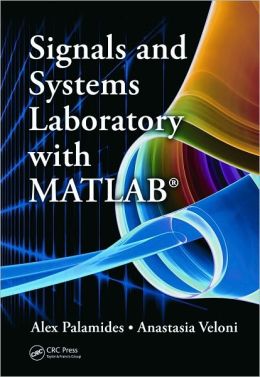 [内容简介]
[内容简介]
With its exhaustive coverage of relevant theory, Signals and Systems Laboratory with MATLAB® is a powerful resource that provides simple, detailed instructions on how to apply computer methods to signals and systems analysis. Written for laboratory work in a course on signals and systems, this book presents a corresponding MATLAB implementation for each theoretical concept introduced, making it a powerful learning tool for engineers, scientists, and students alike.
MATLAB code is used in problems and examples presented throughout the book. This code and other learning materials are available in a downloadable supplement.
Due to the extensive—and truly unique—integration of MATLAB throughout this book, the authors provide a complete tutorial on use of the language for signals and systems analysis. With more than 5,000 lines of MATLAB code and more than 700 figures embedded in the text, the material teaches readers how to program in MATLAB and study signals and systems concepts at the same time, giving them the tools to harness the power of computers to quickly assess problems and then visualize their solutions.
Among its many useful features, this book:
- Offers complete coverage of the signals and systems theory, starting with elementary signals and concluding with state-space modeling
- Contains more than 400 examples and chapter-end solved problems
- Executes commands one-by-one at the MATLAB command prompt, and results, along with comments, encouraging students to learn MATLAB on the fly
Additional Pedagogical Features:
- A detailed MATLAB tutorial to introduce a beginner programmer to the language
- Laboratory exercises that give students hands-on experience and help professors organize a course laboratory component
- Presentation of continuous- and discrete-time in parallel fashion, effectively illustrating the similarities and differences between the two
- Step-by-step examples that present data in tabular format and usually offer several different solutions to each problem
[目录]
Introduction to MATLAB®
Working Environment
Getting Started
Memory Management
Vectors
Matrices
Plotting with MATLAB
Complex Numbers
M-Files
Input-Output Commands
File Management
Logical-Relational Operators
Control Flow
Symbolic Variables
Polynomials
(Pseudo)Random Numbers
Signals
Categorization by the Variable Type
Basic Continuous-Time Signals
Discrete-Time Signals
Properties of Signals
Transformations of the Time Variable for Continuous-Time Signals
Transformations of the Time Variable for Discrete-Time Signals
Systems
Systems Classification
Properties of Systems
Time Domain System Analysis
Impulse Response
Continuous Time Convolution
Convolution Properties
Interconnections of Systems
Stability
Discrete-Time Convolution
Systems Described by Difference Equations
Filters
Stability Criterion for Discrete-Time Systems
Systems Described by Differential Equations
Step Response of a System
Fourier Series
Orthogonality of Complex Exponential Signals
Complex Exponential Fourier Series
Trigonometric Fourier Series
Fourier Series in the Cosine with Phase Form
Plotting the Fourier Series Coefficients
Fourier Series of Complex Signals
Fourier Series of Periodic Signals
Line Spectra
Properties of Fourier Series
Symmetry
Parseval’s Identity
Criterion for the Approximation of a Signal by a Fourier Series Expansion
Relationship between Complex Exponential and Trigonometric Fourier Series Coefficients
Fourier Transform
Mathematical Definition
The Commands fourier and fourier
Fourier Transform Pairs
Properties of Fourier Transform
Convolution in Time and Frequency
Symmetry of the Real and Imaginary Parts of Fourier Transform
Parseval’s Theorem
Autocorrelation and Cross-Correlation
Fourier Analysis of Discrete-Time Signals
Discrete-Time Fourier Transform
Properties of Discrete-Time Fourier Transform
Parseval’s Theorem for Discrete-Time Fourier Transform
Discrete Fourier Transform
Properties of Discrete Fourier Transform
Inverse Discrete Fourier Transform
Circular Shift of a Sequence
Circular Convolution
Fast Fourier Transform
Relationship between DFT and DTFT
Relationship between Fourier Transform and Discrete Fourier Transform
Linear Convolution Computation via Fast Fourier Transform
Frequency Response
Continuous-Time Frequency Response
The Command freqs
The Command lsim
System Response to Sinusoidal Input
Ideal Filters
Frequency Response of Discrete-Time Systems
The Command freqz
System Response to Discrete-Time Sinusoidal Input
Moving Average Filter
The Laplace Transform
Mathematical Definition
Commands laplace and ilaplace
Region of Convergence
Laplace Transform Pairs
Laplace Transform Properties and Theorems
Partial Fraction Expansion of a Rational Function
Convolution in Time and in Complex Frequency
Using the Laplace Transform to Solve Differential Equations
z-Transform
Mathematical Definition
Commands ztrans and iztrans
Region of Convergence
z-Transform Pairs
Properties of z-Transform
Partial Fraction Expansion of a Rational Function
Using the z-Transform to Solve Difference Equations
Transfer Function
Continuous-Time Systems
The tf Command
Stability of Continuous-Time Systems
Transfer Function in Zero-Pole-Gain Form
Interconnections of Systems
Continuous-Time System Response
Discrete-Time Systems
The Command tf for Discrete-Time Systems
Stability of Discrete-Time Systems
Discrete-Time System Response
Conversion between Continuous-Time and Discrete-Time Systems
Transfer Function and Frequency Response
Bode Plot
State-Space Representation
Suggested Laboratory Exercises
Introduction to MATLAB
Signals
Systems
Time Domain System Analysis
Fourier Series
Fourier Transform
Fourier Analysis of Discrete-Time Systems
Frequency Response
Laplace Transform
z-Transform
Transfer Function
Appendices
References
Index

 新书报道
新书报道